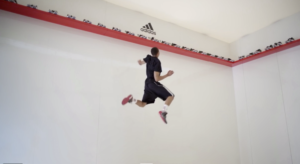Public Relations Experts CBC Analyze Four Experiential Marketing Efforts
For more than 15 years, Cercone Brown has been a unique voice in the world of media and public relations. We have always believed that the best way to help journalists, producers, and editors tell the best stories about brands is by giving them a great way to experience them first hand, in a relevant context. In the buzz words of today, we were an early leader in “experiential marketing.” As the media world continues to evolve and include so many new voices – from professional influencers to the personal communication expectations inherent in social media – we continue to provide innovative experiences for the press, and directly for consumers, that help brands get their stories told as widely as possible. Let’s take a look at some of the more famous experiential marketing executions and break down why they worked, and what you might be able to take away to apply to your own business goals.
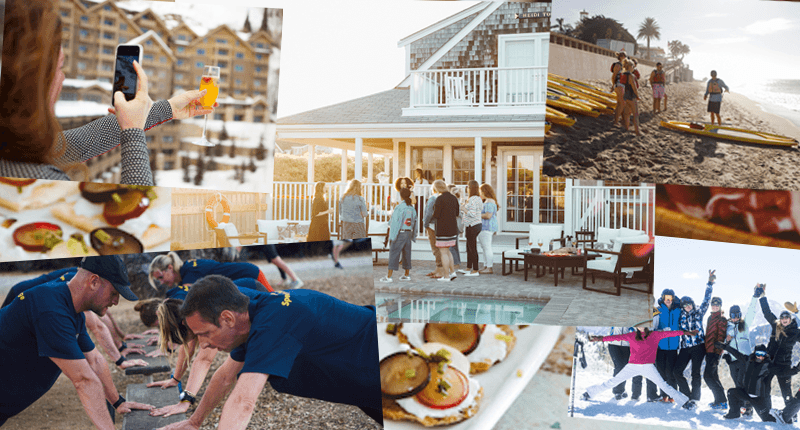
TABLE OF CONTENTS
- What does Experiential Marketing have to do with PR?
- Ikea Experiences on Streets, Water, and in the Kitchen
- What Can Retail Brands Learn from Ikea’s Experiential Marketing Efforts?
- Volkswagen Plays the Town and Drives a Museum
- What Can Brands Derive from Frauhaus Frivolity?
- Adidas Jumps Through Hoops, Pounds Pavement, and Gives Back Energy
- What Can Other Brands Net from Adidas’ Activities?
- Heineken Takes Aussies to a Virtual World Party While Asking the Brits to Have a Beer With the Enemy
- How Can Mission-Driven Brands Avoid a Pepsi Stumble While Striving for Heineken Heights?
EMAIL CHECKLIST
Keep this handy checklist to help you strategize. Enter your email address and we will send you a PDF of our Experiential Marketing Tactics Checklist.
First – What Does Experiential Marketing Have to Do with Public Relations?
Just a decade ago, traditional press relations professionals spent much creative energy competing for journalists’ attention. Today, the publishing industry has blown-up and reconfigured itself several times as consumers and businesses are slowly leaving traditional paper-based media behind while exploring a still-evolving, mostly digital, media landscape.
Now, brands need the creative expertise of PR professionals more than ever to attract the attention of a wider variety of journalists, as well as a new breed of media content creators called “influencers.” To attract the attention of journalists, editors, social media personalities, and celebrities, we have perfected the art of creating experiences that taste-makers wouldn’t miss for the world.
The reason these experiences (we call them House Programs) are so effective is that “Experiential” or “Engagement” Marketing invites participation rather than passive observation. The key to the concept is to allow content creators to completely immerse themselves in an experience or situation that is attention-grabbing, hands-on, visual, and most of all, shareable. In the case studies that follow, you will see how the general public participated in each experience. But it is also a powerful business lesson to note that each of these experiences was given much broader exposure by virtue of the fact that journalists, influencers, and even celebrities, expanded the footprint of each experience by telling their stories on their platforms of choice. This storytelling allowed a huge number of people who never participated in the experience directly, to read about, watch a video about, or engage with pictures of each experience.
Thus while experiential marketing might sound like event marketing, the key difference is that with experiential marketing, people are meant to participate in activities that give both professional communicators and the general public, specifically designed activities for sharing of experiences in writing, pictures, video, and more.
Now, let’s take a look at what our data research tells us is the most popular brand associated with experiential marketing: Ikea. Surprised? Read on and find out why!
IKEA EXPERIENCES ON STREETS, WATER, AND IN THE KITCHEN
Swedish home furnishing retailer Ikea celebrated its 75th anniversary in 2018, but they know that marketing to potential buyers today doesn’t mean sending paper catalogs to people’s homes. Instead, Ikea is bringing the catalog to you! Ikea set up 10×10 foot “rooms,” using real furniture and accessories from their seasonal catalog, in popular locations like Times Square in NYC and Bucktown, Chicago. People walking by could simply step inside the rooms, take pictures, and get their hands-on IKEA’s trendy new home furnishing products. Ikea also set up 10×10 spaces like a TV-studio-like green room, complete with virtual reality goggles, so that people could “shop” Ikea’s many thousands of fully furnished “rooms” via a completely immersive virtual reality experience.
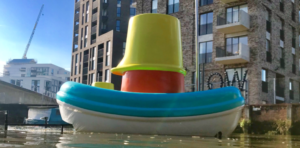
Ikea Smakryp trash-cleaning boat created from their bath model material floated along London’s riverfront picking up trash from the water.
A reportedly important Ikea culture goal is to promote sustainability. In Ikea’s case, that means printing as few paper marketing materials as possible. Digital and experiential marketing tactics are picking up the slack in helping the company promote their products to audiences that are especially responsive to real-life experiences where they can engage with brands and share their adventures on social mediums.
Another successful Ikea experiential marketing effort to promote a new London store — with a nod to sustainability — was their clever idea to build large boats made from the brand’s Smakryp bath model. They sent the boats along London’s rivers collecting plastic and trash in the water. Not only did the brightly colored boats attract tons of attention and selfie opportunities, but potential shoppers could follow the boats along the river to find the location of the newest Ikea location.
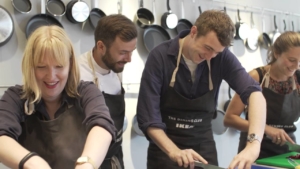
Trained head chefs supervised Ikea customers cooking Swedish delicacies together, while others could participate in inspiring workshops.
A hugely popular segment of Ikea’s product line is kitchenware. Ikea’s team came up with a clever way to connect their kitchenware customers by encouraging them to cook together in their DIY in-store restaurant. Trained head chefs supervised Ikea customers cooking Swedish delicacies together, while others could participate in inspiring workshops. Everyone had the chance to take home a piece of the experience to eat at home.
Ikea’s marketing team is always looking for ways to innovate and evolve business practices to change along with their customers. Like many businesses, they want to connect with people in a way that is meaningful and memorable – not wasteful. Ikea has executed exciting shifts in moving creation and execution away from traditional passive advertising to creating engaging, shareable experiences that are genuinely memorable and (highly share-able) brand encounters.
What Can Retail Brands Learn from Ikea’s Experiential Marketing Efforts?
As we have seen from recent pop culture viral phenomena, an “experience” doesn’t have to be experienced by thousands of people or cost a lot of money to inspire hundreds of thousands of people to share an experience on social media. (ALS Ice Bucket Challenge anyone?) A successful experiential marketing effort does share some key ingredients whether the experience is large or small, expensive or simple. The most important key is that it has to be an experience that people want to be a part of, and secondarily, it has to be an experience people can easily tell others about via words, pictures, and video.
For example, if you own a furniture store in Small-Town USA, it likely isn’t relevant to showcase a new product line in the middle of Times Square. There are, however, community gathering spots or annual events where even the smallest store can creatively insert themselves into the conversation for those who live in the area. To exercise your creativity and experiment with experiential marketing here are some general guidelines to steer your thinking:
- What are some community events happening in the next 6 months to which you could attach your business in some way? In your first attempts in attracting attention outside of your normal place of business, it is more likely to succeed if you are attaching your experiential marketing effort to a location where people are already gathered and open to a compelling experience.
- Think of a way to optimize your experience so that it invites people to take pictures or video to share across social media platforms. Give your idea bonus points if you come up with something that includes your logo, a hashtag, or identifies your business in some way in those videos and pictures.
- Don’t be afraid to choose an experience idea that doesn’t “sell” anything. The key is to be relevant, memorable and shareable. These are long-term brand building exercises, not necessarily an immediate and direct transactional event.
VOLKSWAGEN PLAYS THE TOWN AND DRIVES A MUSEUM
A popular and entertaining experience Volkswagen executed in Germany was intended to encourage subway commuters to run up the stairs rather than use an escalator. A creative soul came up with the idea to turn the staircase directly adjacent to the escalator into a keyboard. Who needs an escalator when you can play a tune with your feet?
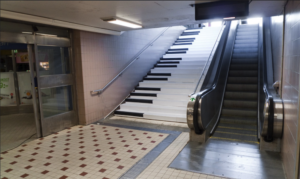
The Volkswagen team created playable stairs in a subway stop in Germany, right next to the escalator. People skipped the escalator for the stairs, playing tunes as they went up and down the steps.
It would be easy for commuters on public transportation to ignore ads touting VW branded cars because cars are mostly irrelevant for those riding a subway. However, Volkswagen installing its piano staircase into a subway terminal inserted itself into the experience that commuters were having at the moment, infusing some fun into a boring routine. Now, when that commuter picks a car to buy for fun weekend trips – who will be the first brand on their minds? We think VW is playing their tune.
Still playing off the roots of their home-country culture, VW expanded the “fun” footprint by taking a page from the famed German Bauhaus art culture. They created a “Jetta Haus” experiential adventure to spread pop-up “museum” locations across America, giving the usual test-drive promotion a jolt of artistic flair. Local musicians and third-party brands SiriusXM, Beats by Dr. Dre, and Red Bull joined the Instagram-worthy effort to connect a newly styled Jetta with local art and music in each town.
What Can Brands Derive from Frauhaus Frivolity?
Volkswagen has a heck of a worldwide public relations challenge to overcome in surviving the reputation hit brought on by the revelation that some of its vehicles were found to be cheating on vehicle emissions. Once a company is able to move beyond the crisis management phase of its communication strategy, VW’s marketing and PR teams have to put on their creative hats and think carefully about how to earn back public trust in the brand. We like the idea that these new experiential marketing concepts harken back to a long-time VW advertising connection to “fun.” For decades, traditional advertising represented VW’s bugs and busses as “fun” in a variety of cultural settings. There is ample, credible cultural opportunity for VW to re-associate their brand with the fun of art, music, and culture through today’s shareable experiences.
One of the toughest challenges any business can face is the challenge of something going wrong – then moving past it. How to best apologize? How do you genuinely own the mistake, but then convince your audience to move on with you and trust your brand again? Dealing with the immediate PR disaster recovery is an art form in and of itself, but in just a few days, weeks or even months, your company will have to start thinking about how to begin marketing again in ways that earn interest and attention – for the right reasons. Experiential marketing can open up a variety of ways to interact with the public because the platform can be completely unrelated to your products or services – such as when VW sponsored the piano staircase in a subway terminal. It was successful because it emphasized the brand concept of having fun anywhere you are, without brokering any opportunity to associate with the brand problem.
As you think through how to do your own relevant experiential marketing, you will see that many companies realize that crafting great experiences can encourage a wide variety of stories, as told by everyone from professional media personnel to thousands of every day social media users.
ADIDAS JUMPS THROUGH HOOPS, POUNDS PAVEMENT, AND GIVES BACK ENERGY
Adidas nailed an awesome experience for their super-psyched customer base in London. Hundreds of kids turned out for their chance to show off their quick-twitch muscles by jumping 10 feet to grab a pair of free Adidas trainers. (That’s high-top sneakers to us Americans.) Fans of basketball superstar Derrick Rose were thrilled to jump with the icon and share their experience – in pictures and video – with hashtags by the handful.

A special installation in the pop-up store acknowledging the emotional history of the Boston Marathon.
Simply qualifying for the Boston Marathon is a huge commitment and accomplishment worthy of much sharing on digital platforms. Adidas decided to celebrate the hard-earned training commitment with a massive 15,000 square foot pop-up store in honor of the anniversary of their 30th year sponsoring the event. Given the emotional backdrop for that particular race, Adidas added thoughtful, relevant touches to the massive pop-up retail effort that made it an experience (instead of just another way to shop). A huge custom message wall graced the center of the space where runners were encouraged to share their unique journeys, serving as a compelling and inspiring series of social media posts for the world to see.
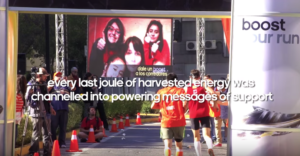
A clever launch of new technology is showcased in Adidas’ sponsorship of this marathon.
Boston’s Marathon has a history and emotional drive all its own, so Adidas had to come up with a more relevant pop-up store experience for runners participating in Santiago Chile’s International Marathon – and boy did they give runners and the crowd something to remember! A clever promotion made a clear connection between Adidas’ new “Boost” brand, named for a technology that uses materials in the shoe sole to return strike energy to the runner and propel them forward. Adidas’ marketing team built an entrance hall out of the “Boost” material, absorbing the step-energy of participants passing through the hall and storing it in a battery. That stored energy was used to power a huge billboard in the last mile of the marathon, lighting up personal messages of support for runners as a scanner sensed bib numbers passing through the area. This was truly a great, unique experience that was just as engaging for the runners’ families and friends as for each race participant.
What Can Other Brands Net from Adidas’ Activities?
While Adidas found a fun and novel way to give away product samples of basketball shoes, they put a new twist on this tried-and-true marketing tactic by making their “product sampling” event serve multiple masters. Instead of simply giving away a bunch of shoes, they “gamified” the giveaway by adding a competitive angle, creating great storytelling fodder for every participant. How high can you jump to get a pair of shoes? How high can you jump when a basketball celebrity is watching you? And if you CAN jump that high, why not bring friends to tell the story, shoot pictures and video, and share with the world?
When setting up pop-up shops, Addias also went the extra mile to make sure runners and their families and friends had ways to connect with the brand in ways other than a direct purchase. Giving runners a heartfelt way to honor the storied Boston Marathon and giving family and friends a fun way to support their runner with encouragement in the last mile of the Santiago Marathon are both great examples of simple-yet-inspirational experiences.
All of these elements of human nature can be woven together into an experience befitting just about any kind of product giveaway you can think of. Have a bakeshop? Host an amateur in-store cupcake decorating contest. Have a small-town newspaper? Run a “day in the life” contest to have people submit their pictures via social media using a hashtag. Remember – if your idea works – it doesn’t have to be a one-off. Make it an annual event! Consistency and relevance remain good rules of thumb for judging the merits of any experiential marketing effort.
HEINEKEN TAKES AUSSIES TO A VIRTUAL WORLD PARTY WHILE ASKING THE BRITS TO HAVE A BEER WITH THE ENEMY
Beer brand Heineken looked for a relevant experiential activity for Australians, in a bid to bring its tagline Open Your World to life and to get Aussie consumers engaged on a physical level with its brand message. They were trying to “forge a deeper connection” and give consumers more local and physical experiences. Heineken wanted to give consumers in Australia an actual taste for what Open Your World means as Heineken defined it. They decided to host a series of secret parties celebrating world cities, culture, nightlife, and food, calling them City Shapers Festivals. Guests were invited to hidden pop-up locations representing some of the hottest lifestyle cities around the world such as Singapore, New York City, and Johannesburg. These City Shapers Festival events brought Open Your World to life with young people. The Heineken Aussie marketing team put a huge amount of thought and detailed execution behind these experiences to make sure that Open Your World did not devolve into a meaningless tag line.

While this experience involved only a handful of people directly, the resulting video was viewed millions of times.
Meanwhile, the Heineken marketing team in London worked to best put relatable value and meaning behind the Open Your World campaign within British culture. They worked with a third party to create a small, intense experience for a handful of Heineken drinkers, recording the entire experience on video. They edited the video and distributed a 4+ minute digital story illustrating that people with wildly different social viewpoints really can sit down over a beer and have a chat without drama and strife.
How Can Mission-Driven Brands Avoid a Pepsi Stumble While Striving for Heineken Heights?
You may recall that a couple of years ago, Pepsi tried to push a similar “can’t everyone just get along” message in a commercial with Kendall Jenner. It spectacularly failed to achieve its marketing goal (while giving the public relations team a chance to practice crisis management), while Heineken managed to score a goal with a different execution. There are some obvious differences in their executions: a 30-second scripted music video with a supermodel versus a four-plus minute commercial that recorded real people in a one-on-one personal setting. But both brands spent much time and effort striving to convince their customers that their brands are squarely on the side of valuing all people from all different walks of life.
The key to achieving success in this brave new world of experiential marketing is to look within and understand your own company as much as (or better) than you know yourself. Authenticity has been a great buzzword in marketing discussions in the last few years, but there is no faster way to have your customers reject a message as disingenuous than to buy marketing content that simply rides on the keyword-coattails of the latest data analytics report.
Successful experiential marketing efforts come from your staff and your partner vendors who both listen carefully and speak to their truth. At Cercone Brown, we look hard for companies we believe in whole-heartedly so that we too are executing what we call Mission Branding.
Experiential marketing isn’t just a stunt or a fad (CBC has designed and implemented more than a dozen multi-day experience marketing events every year for the last 15 years). It’s not something you can execute once, live stream it, and go back to pushing out commercials and sales pitches. Experiential marketing represents a fundamental shift, led by young people who are demanding an experience-driven form of consumerism. This experiential demand doesn’t necessarily mean people buy less beer, sneakers, or lipstick. Rather it means people now tend to buy those things because they identify with something about that brand — the brand’s values, lifestyle, or philosophy, with which customers want to personally and publicly associate. More people are interested in DOING something, participating in activities in new spaces and places, and often with people they don’t already know. Instead of clipping coupons, picking up samples, or reading fliers, we are buying access to firsthand exploration through our branded products and services – and taking pictures and video to share with the world.
Need some creative ideas to help bring your brand to life? CBC can help! Drop us a line here.
About CBC
For more than 15 years, Cercone Brown Company in Boston has been known for providing journalists with entertaining and highly memorable lifestyle experiences in iconic locations, in order to help them create exceptionally popular content for their publications. We continue to analyze the evolving fields of content creation and experiential marketing trends to identify experiences that give journalists, influencers, and digital marketers, an amazing story to share.
EMAIL CHECKLIST
Keep this handy checklist to help you strategize. Enter your email address and we will send you a PDF of our Experiential Marketing Tactics Checklist.
Experiential Marketing Tactics Checklist
Patterns for Success: We used examples straight from our case studies above, but think about ways these tactics may apply to your industry or business category.
- Use influencers. Influencers can be a great way to help promote your branded experience and get people talking about it. Whether your budget allows for macro or celebrity-level influencers or local micro-influencers, the impact can be just as effective in driving the right audience to your experience. For example, Ikea used popular head chefs at their experience, adidas had Derrick Rose attend the Jump Shop, and Airbnb even used a dog influencer (yes, that’s a thing) @MarnietheDog. Are you intrigued by influencer marketing but don’t know where to start? Check out this easy guide on how to choose the right influencer for your brand.
- “Instagrammable” experiences. Today, it is important to curate experiences that are deemed “Instagram-worthy” by both consumers AND the media. Aesthetics are important for easy user-generated content creation, as seen in the Volkswagen pop-up museum and the Ikea “rooms.” Ask yourself: “Does this look cool enough that I would want to take a picture and share with my friends on Instagram?” And of course, this includes Facebook and Twitter. Describing an experience as “Instagrammable” is really just millennial speak for visually shareable.
- Experience & People > Product & Company. While some experiences are clearly just to drive sales (pop-up stores), other successful experiences are clearly and almost purely consumer-focused brand awareness tactics. The Volkswagen piano staircase has nothing to do with Volkswagen products, but it gave people a fun and highly interactive experience provided by the brand. The cooking experience was hosted by Ikea, but the focus of the event was on spending time with family and friends and looked like great fun for those who saw only media coverage and social posts.
- Video production. Many brands feature videos that highlighted the experience (Ikea, Adidas, Heineken) and were subsequently re-used everywhere from advertising, YouTube, and social clips to virtual reality displays. Creating a branded, immersive experience is a perfect backdrop for content! Make sure you take advantage of these moments in time and think about how you can broadcast this to people who can’t attend in person.
- Pop-ups. Ikea, Adidas, and Heineken, all created pop-up experiences that fully immersed consumers in product-centric experiences. This is a great tactic for e-commerce-only companies too. Create a space where consumers can physically experience the brand – touch, feel, and interact with the lifestyle. A few years ago, we did this for online brand Garnet Hill by turning a recycled shipping container into a tiny-home boutique.
- Provide real value. Ikea created workshops where consumers and influencers could have hands-on experiences learning new skills, creating art, or cooking meals. This provides true value from the brand to the consumer.
- Festivals/Tailgates. Brands like Heineken and VW utilized festival-type events with food, music, and games to engage consumers. These are great places to create branded experiences, as consumers are in the right mindset and have the time to interact with you.
- Replicate in different markets or locations. Ikea, Heineken, and Adidas were all brands that featured events in multiple markets but made sure to customize a few details that were key to “localizing” in that area. Whether it’s partnering with local businesses or restaurants, this helps authentically immerse your brand into that market and also creates added exposure and credibility in the community.
- Use of technology. Ikea used virtual reality at its pop-up locations to allow shoppers to “stand inside” their remote showrooms. NPR successfully runs listener engagement events by placing NPR-branded “record your story” recording booths in high-traffic locations (read more about their events here). Today’s branded experiences usually depend on participants using the smartphones in their pockets containing the technology to record video, audio and snap pictures, and share. While smartphones have a great number of interesting applications you can rely on to execute your experience, don’t limit yourself. If other kinds of tech will augment people’s experiences – that is a key consideration. Focus on developing a great experience and expect those who participate will use their tech of choice to share it.
- Public commitment to social values. Heineken’s carefully crafted social “experiment” was executed on a soundstage in order to capture every minute on video and create a well-told story of inclusion. For Ikea, its commitment to sustainability was built into their experience with its branded boat that was actually cleaning up the river.


